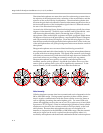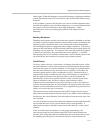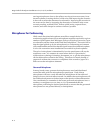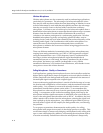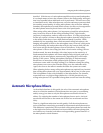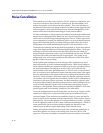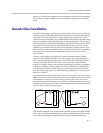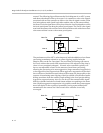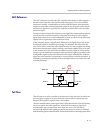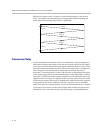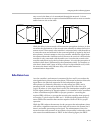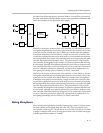
Design Guide for the Polycom SoundStructure C16, C12, C8, and SR12
B - 10
Noise Cancellation
The ambient noise in the room caused by HVAC, projectors, computers, and
even noise external to the room that is picked up by the microphones will
reduce the signal to noise ratio at the microphones. This noise will then be
transmitted to the remote site along with the local talker's audio signal and the
reduced signal-to-noise ratio will contribute to lowered intelligibility of the
remote audio and increased listener fatigue for the remote talkers.
It is best to eliminate or at least reduce the ambient noise through architectural
means such as changing HVAC ductwork, moving microphones away from
noise sources, and removing or dampening noise sources. If these approaches
are not adequate or possible, an additional option is to process the microphone
signal with advanced signal processing techniques that reduce the level of
background noise while maintaining the quality of the local talker's voice.
Techniques for reducing the background noise picked up by the microphone
range from simple noise gates to advanced digital adaptive filters. Noise gate
techniques will reduce the noise when the local talkers are not talking by
suppressing the signal that is below a given threshold, but the noise will still
be present when the local talkers begin to speak again. The gating of the
background noise will sound unnatural at the remote site as the local talker
speaks and then stops speaking.
More sophisticated techniques such as adaptive filter techniques are used
quite successfully in audio conferencing applications. While not all adaptive
noise reduction techniques (commonly referred to as noise cancellation) have
the same performance, the objectives are the same - to first identify the
characteristics of the noise (broadband such as HVAC noise, or narrowband
such as a whine from a mechanical source) and then remove that noise signal
from the microphone audio signal without any additional information about
the noise. These techniques work best with noise that has stationary statistics
-for instance, the noise signals may be random, but the style of randomness is
fixed such as the noise from a fan source. As these techniques typically take
several seconds to identify the characteristics of noise, these techniques do not
work well with impulsive noises such as clicks from pen tapping or paper
rustling on a microphone. These systems are typically designed to work with
speech signals and are not usually suitable for use with music.
As not all implementations are the same, there can be a large variation in the
amount of residual noise or spectral artifacts that are introduced into the
processed signal. These artifacts can sound like chirps or worse and may be
perceived to be worse in quality than the original noise. These artifacts may be
minimized by lowering the amount of noise cancellation provided - typically
it can be adjusted from 0 to 15 dB or more. With current techniques 5 -10 dB of
noise cancellation can be achieved without significant distortion of the
underlying local talker's signal (depending on the manufacturer).
Ceiling microphones benefit the most from noise cancellation techniques as
these microphones are closest to the ceiling noise sources of HVAC and
projectors. The noise cancellation can make an otherwise useless room usable.





